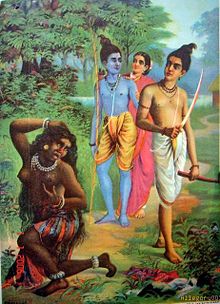Shurpanakha
Shurpanakha ( Sanskrit शूर्पणखा śūrpaṇakhā ) is a Rakshasa from the Indian national epic Ramayana and there the sister of the ten-headed demon prince and king of Lanka , Ravana . Her actions are the cause of the later kidnapping of Princess Sita by Ravana.
The Ramayana
The Ramayana epic was written between the 4th century BC. And the 2nd century AD in India. It is an art poem consisting of 24,000 double verses, which is attributed to the legendary singer Valmiki and has been largely complete since the 2nd century AD. Spreading with the Indian religions, it developed a very large cultural influence in Southeast Asia and was adapted to regional conditions. In Thailand, as Ramakian, it has become the founding legend of the Chakri dynasty , which sees itself in a line of descent with Rama, while in Indonesia, for example, it significantly shaped Wayang and Kecak and in the Khmer empire the temple and palace buildings of Angkor . In India it is the second national epic alongside the Mahabharata .
Shurpanaka in Ramayana
Shurpanakha is the youngest child of the Rakshasa Vishrava and Kaikasi. Her husband is Vidyujjibha, the king of Kalakas. This is later killed by Ravana because he did not support him enough in a battle.
When Shurpanakha walks in the Dandaka forest, where she lives, and meets Rama , who is in exile with his wife Sita and his half-brother Lakshmana, she falls in love with him. Rama refers the demoness, who is of gruesome and misshapen form, to the unmarried Lakshmana . When Shurpanakha asks Rama's half-brother to marry her, he mocks her by praising her beauty and lamenting the advanced age and ugliness of Sita. Lakshmana goes on to say that he is not worthy of her and that she should turn to Rama again, who is surely tired of his wife. Shurpanakha takes his words seriously, then goes into Rama and Sita's tabernacle and wants to devour the princess. Rama is able to stop them and reproaches his half-brother for his mocking speech. After his brother tells him to do so, Lakshmana mutilates the demoness by cutting off her nose and ears with his sword.
The defaced Shurpanakha flees to Janasthan, a part of the forest of Dandaka, to her brother Khara , tells him about her suffering and shows him her wounds. He sends 14 demons of his retinue from Rama, Sita and Lakshmana to kill while Shurpanakha shows them the way. When it comes to the fight, Rama can kill all demons with his bow and Shurpanakha flees back to her brother Khara. She complains about Rama's strength and scornfully calls on Khara to flee Gandaka because he is not up to it. With this she incites the demon's anger all the more, whereupon he orders his general Dushan to collect 14,000 rakshasa in order to fight against Rama. Khara himself leads the group with his golden chariot. While Sita hides in a mountain cave under the protection of Lakshmana, Rama can defeat the entire army and Khara in a three-hour battle alone. When she hears the outcome of the fight, Shurpanakha flees to her brother Ravana in Lanka.
She accuses him of selfishness, carelessness and weakness and that he fails to protect his kingdom and to look beyond its borders. Then she tells him about Rama's victory over the 14,000 demons as well as Khara's death and the loss of Janasthan. She warns Ravana that he is in danger of losing his kingdom because he is a bad ruler. Shurpanakha stirs the wrath of the Demon King, who can only die by human hands, and he finally asks about Rama. She tells him of the prince's strength, her mutilation by Lakshmana, and extols the beauty of Sita. At the end of her speech, she tells her brother that Sita is a worthy bride for him and calls on him to take revenge for his slain brother and kidnap the princess. Immediately afterwards, Ravana makes his way to his uncle Maricha , who supports him in the later deportation of Sita to Lanka.
In the further course of the Ramayana Shurphanakha plays no role and is no longer mentioned.
Web links
Individual evidence
- ↑ These and all other information come from the literature given
- ↑ Hari Prasad Shastri: Ramayana . The story of Prince Rama, the beautiful Sita and the great ape Hanuman. In: Diederich's yellow series . Heinrich Hugendubel, Kreuzlingen 2004, ISBN 3-89631-431-9 , p. 296 .
